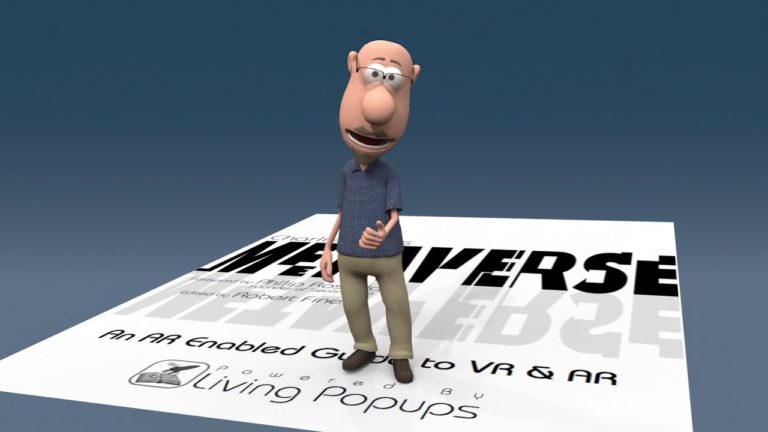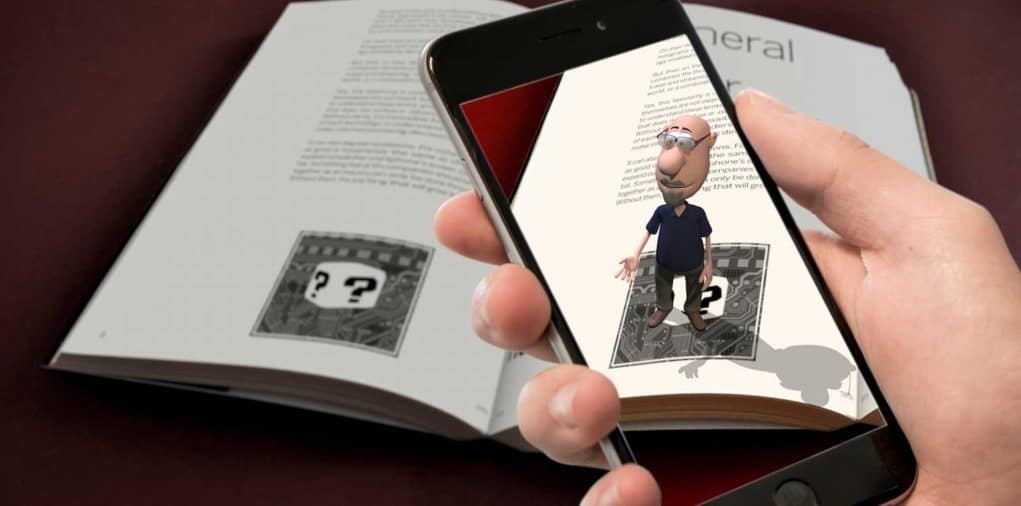
The first thing you may notice about Charlie Fink’s Metaverse is that it truly is meta. Like Kramer’s coffee table book about coffee tables that turns into a mini-coffee table, Metaverse is delivered along with the AR medium that it examines.
This is to walk the walk, but also to infuse dynamism in an inherently static medium. In fact, Fink admits in the second page turn that the book is already out of date. This is why few people tackle such a fast-moving topic in book form, he says. So he’ll provide ongoing updates online.
Another thing few people do is achieve meaningful depth on the topic of XR. As Fink rightly points out in the book’s introduction, the majority of XR-related ink is spilled over flowery depictions of world-changing technology with no real technological or cultural barriers worth mentioning.

Deeper Dive
So Fink sets out in Metaverse to defy that trend with a multi-dimensional look at XR. Just as his AR avatar signals readers at the onset, Fink dives into XR’s drivers and beneficiaries: tech, society and business. These themes map to three points he explicates early in the book.
1. Tech succeeds when it makes what we’re doing better, faster and cheaper.
2. The killer app is other people.
3. We always over-estimate the short term and under-estimate the long term.
Zeroing in on the second point, people and society play a key role in the book. Fink in fact predicts that XR’s biggest killer apps will be social. This extrapolates his prolific view of tech history, such as what Love@AOL showed us as a precursor to social networking and Facebook.
Drilling down further, social collaboration is currently missing from most mobile AR apps, but has the potential to drive immense value, a la network effect. But it first requires better multi-player support, as well as a robust AR cloud, as contributor Ori Inbar examines in one chapter.
As for XR’s business dynamics, Fink again draws from a prolific career spent cross-training in various tech and media sub-sectors. He seeing giants “with huge margins for error” making big XR bets which will continue, including tech’s four horsemen and his former employer, Disney.
Meanwhile, product strategies and business models are starting to materialize, as we examined in our latest report. Fink does justice by level-setting on monetization structures, as does contributor Stephanie Llammas in one chapter. But he admits there’s ample room for surprise and innovation.
“The Internet, in my view, has four killer apps that make it indispensable,” Fink writes. “Email and messaging, e-commerce, search and social media. There are as yet no equivalent applications for VR and AR, though there are early signs of what those could be.”

Timing is Everything
Other well-devised book components and level setting include early definitions of the XR alphabet soup. Fink boldly treads into contentious territory of defining industry terminology, through his own commentary as well as that of fellow thought leaders and industry-watchers like Llammas.
As for overestimating the short term and underestimating the long term (point 3), this brings up a key theme within the book which is timing. The above draws from a Bill Gates quote while also bringing to mind another Bill: Bill Gross stresses that timing is everything in tech & business.
Fink goes back even further for insights on opportune timing. Beyond tech revolutions, there are historical lessons in other things like gold rushes (the actual kind). There, Fink taps into Enlightenment-Age thinking. Quoting his quote from Voltaire:
“To get rich, discover where gold will be discovered in the future and be there when it arrives.”
This of course requires foresight and a lot of luck — another Bill Gross success factor. But the focus on timing has another hidden message. Because the magic lies in the “when” and “how,” it stands to reason that the question of “if” has an inevitable outcome. We’re with Fink on that.
“As consumer computing shifted from laptops to smartphones, so will telecommunications switch from phones to headsets,” Fink writes in the book’s introduction,” but not as fast or in the way we would like them to.”
See more about the book on its website, including ongoing content updates. You can buy a copy on Amazon. We get no affiliate fee, nor perform paid reviews. We purchased our copy of the book. See disclosure and ethics policy here.
For a deeper dive on AR & VR insights, see ARtillry’s new intelligence subscription, and sign up for the free ARtillry Weekly newsletter.
